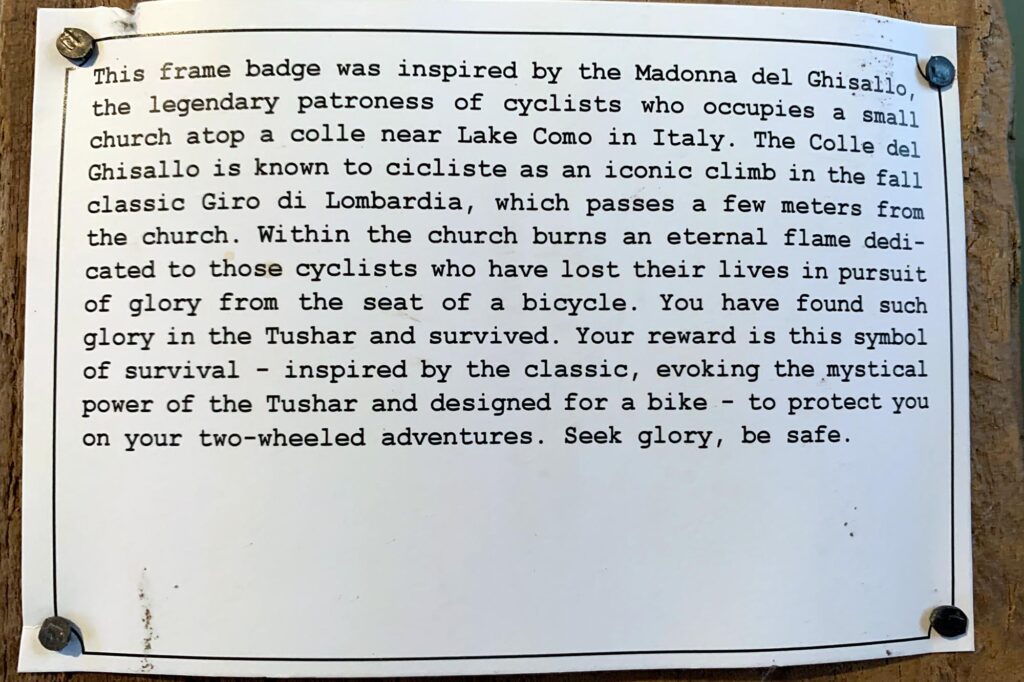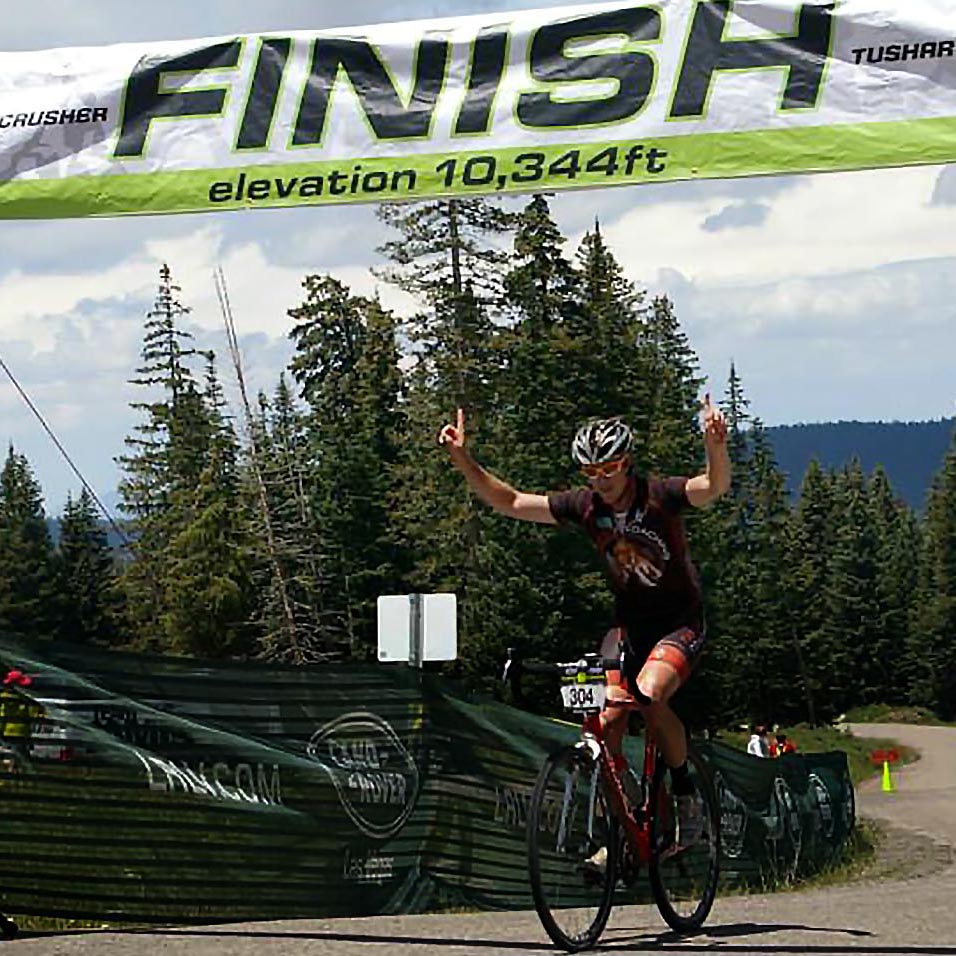When PEARL iZUMi asked me to write about Gravel Then and Now, I think they were thinking of me going back to 2013 when I won the Crusher in the Tushar. There’s a whole backstory there which mostly centers around getting divorced, losing 50% custody of my two daughters, and consequently spending 50% of my weekends coping by riding all day in the Colorado mountains.

One can get hella fit figuring out life and ‘soul riding’ all day, so after six weeks, I needed to scratch my competitive itch. Not in a road race – I’d done hundreds of those. Nor a mountain bike race – I needed something epic. I wanted a road trip, an adventure, and a solo journey for a true test of my body and mind to purge my pain and reward my suffering.
I had heard about this race called the Crusher in the Tushar, which had the slogan “no matter what bike you ride, at any one point in the race, you’ll regret it.” So I packed up my cyclocross bike, threw on some tubeless ‘cross-file treads, swapped out my gears for more climbing, and went on a road trip.

And it was all true – the CX bike wasn’t that great for climbing, but the tubeless tires prevented me from flatting, and I got dropped on the downhill by all the guys on mountain bikes, but I caught and passed them on the long paved runout. At the start of the race, the announcer heckled us about the pain and suffering we were about to endure, and I was nervous and scared. Once the race started, I loved every minute. I suffered like a dog up the first climb, but the pain wasn’t nearly as bad as missing my girls. Later on in the race, as I began climbing the legendary “Col de Crush,” I had no idea how hard it was going to be, so it was an “ignorance is bliss” type of situation. Not many people had talked about this part of the race, so I had no clue. Plus, at that point, I was in the lead and locked in the zone of getting to the finish by holding the steady suffering.
For another two hours, it was a wild ride up a nasty surface, hot as all heck. I arrived at the KOM with volunteers giving my coca-cola hands, water spritzers but dang if the climbing wasn’t over! There was no descent but there were random dudes dressed up like forest creatures passing out dollar bills and encouraging us all on. At the bottom of the final climb, when you’ve already emptied the tank, there’s a stake in the ground compliments of promoter Burke as a Devil heckling you, “Not done yet.” It was all refreshingly wacky, and unlike any bigtime road race, I had ever done.
At the finish line, the announcer knew my name and put a beer in my hand. There were high fives from my fellow competitors, and it was an “I know you from my mountain biking race days.” I know you and you and you…and it was awesome. A reunion of sorts and so good to see my former competitors still out here doing the same thing they were great at when things were simpler on the mountain bike scene.
We continued the good times with a post-race buffet luncheon in a ski lodge with more beer, hot tubs, a band, and a kick-ass awards ceremony where we stood atop different sized colored oil drums. The prize swag included all the brand partners from the race: a KUHL jacket, an ENVE wheelset, and a homemade trophy inspired by the Madonna del Ghisallo. The award sits in my office beside my 1998 Boulder Roubaix Cat 3 trophy, which coincidentally is a road race on dirt!, the OG Gravel race?!


So yea, I found my tribe again, and I’ve gone back to Beaver, Utah every summer except a few to try and relive the glory from the day, and my quest continues. But back to the dirt theme and the 1998 Boulder Roubaix – that was a road race and it was on dirt (gravel roads) but we raced on road bikes. Hmmm, is that where gravel begins, the then and now? Nah, there was no vibe to that race, barely an awards ceremony, certainly no beer, and I got yelled at in the race for things I didn’t know, for it was my first Cat 3 race…ever. “Pass, please.” Besides, I was a mountain biker anyway, and the Boulder Roubaix was a training race for mountain bike season.
Thus Gravel’s then goes further back than 2013 and even further back than 1998. But those are critical developmental moments that would have brought gravel to where we are now.
Actually, where gravel is today really began in the 1990s during the US mountain bike race scene. The scene being the expo area and the town the race was hosted.
The more I think about where gravel is in 2020, the more I am reminded of my first World Cup Mountain Bike Race in 1996. In between graduate school biochemistry and endocrinology exams, I road-tripped down to Helen, GA, for a World Cup and NORBA National Mountain Bike Race. I was a complete newb and entered the Sport Class MTB race. It was going to be my third ever cycling race (let alone MTB race), and I had just charged a Specialized Stumpjumper with Rock Shox Judy on my brand new, first-ever VISA credit card. Plus, I’d get to see all the pros that were in the magazines, not just Americans but the Euros too.
Upon my arrival, I met up with some friends that I met while riding single track at Hobby Park in Winston-Salem, NC. I did my first ever race there – no license necessary, and the promoter was doing something called “fees in > fees out,” which I think was equivalent to putting all the race fees in a hat and then distributing all the money out to the top five finishers. It really didn’t matter to me because these guys were all way faster than me, and I had no chance of winning. So I lined up in back and tried not to get lapped 3-4 laps later.
Anyways, driving into Helen was sort of like driving to a Grateful Dead concert. The closer you got, the more the vehicles you’d see with mountain bikes on them and bike brand stickers on the bumpers. I turned the corner on the main street, and there it was, a giant expo the size of a football field full of tents and booths of bike companies whose products I had lusted overall winter in Mountain Bike Magazine. Jackpot!
I pulled into the hotel parking lot – a two-story hotel with Bavarian styling and a long continuous deck outside. There were fully wrapped team trucks and trailers in the parking lot. I had found my Woodstock. The Ritchey Mountain Bike Team was there. They were one of the best. Once in my room, there was a ruckus outside, some laughing and running, so I went out to see what the commotion was. Thomas “Frishy” Frischknect and his teammate Sheri Kain were having a Nerf ball gunfight. They chased each other up and down the outside deck laughing and having a grand ole time. I immediately had a crush on Sheri and was an instant fan.
But Frishy – he was famous. He was in all the magazines I had read word for word, page by page for the last year—one of the best. I did not know what pro mountain bikers did or did not do, but to run around having fun playing Nerf guns, that looked pretty damn good and made me want to be a part of that lifestyle. Crazy enough six years later, I was fortunate to ride for the Ritchey Mountain Bike Team for the 2002 NORBA NATIONAL Series.
On a feel-good high, I walked over to the expo area from the hotel and felt like a kid in a candy shop. Front and center, Oakley had a massive dual axle Ford F250 pick up truck with a cap that was fully wrapped with branded colors and logos. You could buy a pair of Oakleys out of the back of the pickup truck on the spot. I couldn’t afford a pair being in graduate school, but I sure did want a pair. Years later, all my eyewear are Oakley’s now that I can afford them. Next to the Oakley truck was the Gore-Tex Cable tent. If you left your bike with them for 2-3 hours, they’d install Gore cables on your bike. For free. Sold! I used those cables for next year, and when they wore out, I asked my local bike shop to put a new set on. Now we have electronic shifting, oh well…
Next to the Oakley and Gore Tent was the KORE booth. They had really cool ads in the magazines and made some sikk stems and handlebars. I bought this hulk of a stem for $35, and the KORE rep installed it on the spot. I felt so cool, and I was so proud of my Specialized Stumpjumper that was now custom.
Then next to the KORE Tent was the SDG booth – they had really cool saddles with kevlar on the sides in case you crashed. I crashed a lot, so this was a great idea to me. I was all out of money so I couldn’t buy one, but I took a picture of the saddle in my head, and a few months later I bought one from my local shop.
The expo was amazing, and I was hooked. The next day I raced in the Sport Men’s field and, literally, 300 feet after the start, I snapped my chain. D’oh! I didn’t even know what a chain tool was, but I didn’t care because I was with my mountain bike tribe. And besides, back at the Pedro’s booth, they fixed and gave me a new chain, and guess what? I’ve been a Pedro’s customer ever since.
I watched the pro’s race the next day, which was a World Cup event. Not just American’s but the Euro’s as well. American Julie Furtado won women’s, and Frenchman Miguel Martinez won the men’s. John Tomac was the top American, and he went on to be my favorite along with Ned Overend, and Tinker Juarez. I hiked all over the course to the most technical descents and ran all the way back through the woods to catch the finish.
It was a great weekend, and I drove back to graduate school, feeling like I had found my tribe. That is the same feeling I get when I go to a gravel race these days. Bringing it full-circle to gravel now, the vibe is in the tribe. The people, the town, the lore of the race and the expo with all the brands that I lust over the magazines…er internet all winter.
The gravel scene is now is where mountain biking was in the nineties. Those were some darn good years, so I think we have a lot more to look forward to in the future. Old-timers will remember the gravy train days of big money sponsorships and gobs of media coverage; Euro road race defectors (Raul Alcala and even Bobke
Let’s not forget the history of mountain bike racing. A meteoric rise and fall through the years now can serve as a road map for gravel exploding forward into the future. And with that, I resign my time to the floor to go ride my bike, any bike on any terrain.








Comments